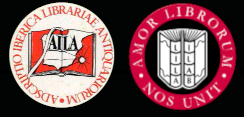


Home |
Temáticas |
Catálogos |
Pedidos |
  |  |
|||||||
|

|
RUGENDAS. (Johann Moritz) HABITANTE DE GOYAS, QUADRO A ÓLEO PINTADO SOBRE MADEIRA. |
|
|
Clique nas imagens para aumentar. SÁ CARNEIRO. (Carlos Augusto de) LINHAS TELEGRAPHICAS DO CONTINENTE DO REINO, ILHAS ADJACENTES E PROVINCIAS ULTRAMARINAS .Por... Tenente de engenheria. Escola Pratica de Engenheria 1894-1895, 1.ª Parte do curso para sargentos da companhia de telegraphistas. Imprensa Nacional. 1897. De 22,4x14 cm. Com 90, [ii] págs. Encadernação da época com a lombada em pele com ferros a ouro. Ilustrado no texto com quadros resumindo as estações e linhas telegráficas existentes, com os indicativos das estações militares, com uma lista das estações telegráficas civis do continente e ilhas adjacentes e com quadros com as taxas. Em extratexto está ilustrado com 20 gravuras técnicas relativas ao material usado, em 9 folhas desdobráveis intercaladas nas folhas de texto e com 11 cartas geográficas desdobráveis no fim da obra, com as seguintes redes telegráficas: Zambézia e Chire; Ilha de S. Miguel, Açores; de Angola; do Grupo central das ilhas dos Açores; na Madeira; da rede telegráfica militar no Porto e em Lisboa; da rede telegráfica militar de todo o continente; carta, a cores, com as grandes comunicações telegráficas do mundo; e 3 cartas geográficas de grandes dimensões com a rede telegráfica no continente. Exemplar com assinatura de posse na folha de rosto de José Tavares de Araújo e Castro, e com desgastes na lombada, nas charneiras e cantos. Obra muito rara e importante para a história das comunicações telegráficas e telefónicas em Portugal, assim como sobre a história da engenharia militar portuguesa, notável pela riqueza e pormenor das numerosas ilustrações. Com um especial valor por ser da autoria do pai do poeta Mário de Sá Carneiro, que apoiou o seu filho na sua educação e actividades literárias. Carlos Augusto de Sá Carneiro (Lisboa, 1871 - Lisboa, 1952). Oficial da arma de engenharia, atingiu o posto de coronel e foi director dos Caminhos de Ferro de Moçambique. É autor de mais de uma dezena de obras técnicas sobre fortificações e comunicações militares. Foi pai do poeta Mário de Sá Carneiro. Além de ter pago os estudos em Coimbra e Paris do seu filho, foi ele que lhe deu o dinheiro para a publicação da célebre revista Orfeu. Era proveniente de uma família de militares. O seu bisavô foi António de Sá Carneiro, que integrou a Legião Portuguesa, corpo de exército de portugueses ao serviço de Napoleão, e não voltou a Portugal, tornando-se oficial do exército francês. O seu avô José Paulino de Sá Carneiro (Bragança, 1808 - Lisboa, 1891) foi oficial do Exército, participou na Guerra Civil de 1828-1834, atingiu o posto de General, foi comandante do Batalhão de Caçadores, n.º 4, do Regimento de Infantaria n.º 7, director do Colégio Militar, Comandante da Divisão de Viseu e depois da Divisão do Porto. Seu pai José Paulino de Sá Carneiro, Júnior (Porto, 1849 - ?) foi Inspector geral das Alfândegas de Lisboa e adquiriu a Quinta de Nossa Senhora da Vitória, em Camarate, que hoje está ocupada pela Casa de Repouso para os Motoristas de Portugal. Nela o poeta Mário de Sá Carneiro, filho de Carlos Augusto, passou a maior parte da sua infância e existe correspondência dele com o seu avô.
Illustrated in text with tables summarizing the existing telegraph stations and lines, with the callsigns of the military stations, with a list of the civil telegraph stations on the mainland and adjacent islands, and with tables showing the rates. Illustrated hors-texte with 20 technical engravings relating to the material used, on 9 fold-out pages interspersed with the text pages and with 11 fold-out geographical charts at the end of the work, with the following telegraphic networks: Zambézia and Chire; Island of S. Miguel, Azores; of Angola; of the Central Group of the Azores islands; on Madeira; of the military telegraphic network in Oporto and Lisbon; of the military telegraphic network of the whole continent; chart, in colour, with the great telegraphic communications of the world; and 3 large geographical charts with the telegraphic network on the continent. Copy with handwritten ownership title on title page from José Tavares de Araújo e Castro, and with signs of wear on the spine, hinges and corners. Very rare and important work for the history of telegraph and telephone communications in Portugal, as well as on the history of Portuguese military engineering, remarkable for the richness and detail of the numerous illustrations. Of special value as it is by the father of the poet Mário de Sá Carneiro, who supported his son in his education and literary activities. Carlos Augusto de Sá Carneiro (Lisbon, 1871 - Lisbon, 1952). Officer of the engineering branch, attained the rank of colonel and was director of the Mozambique Railways. He is the author of more than a dozen technical works on fortifications and military communications. He was the father of the poet Mário de Sá Carneiro. Besides having paid for his son's studies in Coimbra and Paris, it was he who gave him the money for the publication of the celebrated magazine Orfeu. He came from a military family. His great-grandfather was António de Sá Carneiro, who joined the Portuguese Legion, an army corps of Portuguese serving Napoleon, and did not return to Portugal, becoming an officer in the French army. His grandfather José Paulino de Sá Carneiro (Bragança, 1808 - Lisbon, 1891) was an army officer, took part in the 1828-1834 Civil War, attained the rank of General, was Commander of the Caçadores (Chasseurs) Battalion No. 4, Infantry Regiment No. 7, Director of the Military College, Commander of the Viseu Division and then of the Porto Division. His father José Paulino de Sá Carneiro, Júnior (Porto, 1849 - ?) was General Inspector of Customs in Lisbon and acquired the Quinta de Nossa Senhora da Vitória, in Camarate, which today is occupied by the Casa de Repouso para os Motoristas de Portugal (Portuguese Driver's Retirement Home). In it the poet Mário de Sá Carneiro, son of Carlos Augusto, spent most of his childhood and there is correspondence from him with his grandfather. Referências/References: Inocêncio V, 86-87 e XIII, 152, sobre o bisavô e o avô do autor. Referência: 2302PG005
Local: M-9-B-55 Caixa de sugestões A sua opinião é importante para nós. Se encontrou um preço incorrecto, um erro ou um problema técnico nesta página, por favor avise-nos. 
|
Pesquisa Simples




|
||
 |
|||
|